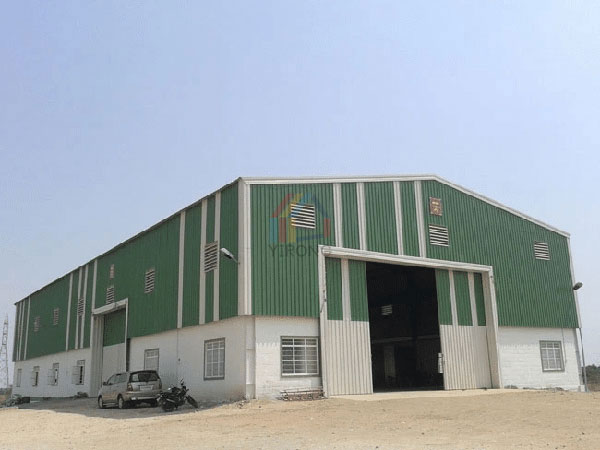Design requirements for steel beam section of steel warehouse building
The size of the steel beam section of the steel warehouse building must be determined by calculation, and meet the three main requirements of strength, overall stability and stiffness. The first two ensure the safety of steel beams in use, and the latter ensure that there will be no excessive deformation for normal use.

1. Strength
The strength of steel beams in steel structure warehouses includes the ability to resist bending, shearing and vertical local compression. The bending resistance can be obtained from the bending stress formula in the mechanics of materials. When designing according to the elastic stage, the edge fiber stress of the calculated section is taken to reach the yield point of the steel as the limit state. After the edge fiber stress reaches the yield point, the beam can actually continue to carry the load.
As the load continues to increase, the plastic deformation on the section where the maximum bending moment is located continues to develop and expand from the edge to the center along the section, and finally a plastic hinge is formed at the section. After a certain number of plastic hinges appear on the beam of the steel warehouse building, the beam will reach the limit state of bending resistance and be destroyed.
When designing according to plastic, consider the formation of plastic hinges on the beam and the redistribution of internal forces caused by it. Compared with the beams designed according to the elastic stage, the steel beams of the steel structure warehouse building with plastic design can reduce the section size and save the steel. However, it is generally only suitable for hot-rolled steel beams and constant-section welded composite beams subjected to static loads. At the same time, the width-to-thickness ratio of composite beams should be strictly limited to avoid local instability of the plates and reduce the bearing capacity of the beams.

2. Shear resistance of steel beams
The shear resistance of steel beams in metal warehouse buildings can also be calculated according to the relevant formulas in the mechanics of materials. For simplicity, it is generally assumed that the shear forces are fully absorbed on average by the calculated section of the web. The web of the section steel is thicker, and the shear strength can generally meet the design requirements.
When the flexural strength of the beam is designed according to the plastic stage, the existence of shear force will accelerate the formation of plastic hinges. Therefore, there should be a relatively strict limit on the shear stress on the maximum moment section. Where the steel beam of the steel warehouse building bears a fixed concentrated load (including the support of the beam), when the load acts on the flange, the horizontal section of the web at the junction of the flange and the web shall have sufficient vertical resistance. Ability to apply local pressure.
The area of the horizontal section of the web under vertical local pressure is the product of the assumed distribution length of the vertical pressure on the checked horizontal section and the thickness of the web, and it is assumed that the vertical compressive stress is uniformly distributed on the horizontal section. If the calculated vertical local bearing capacity of the steel structure warehouse section is insufficient, the length of the backing plate supporting the vertical load can be enlarged, or the stiffening rib of the web plate can be set there.

3. Overall stability
Under the action of vertical load, the steel beam of steel warehouse building generally only produces vertical displacement (ie deflection). However, for I-section or channel-section steel beams with poor lateral stiffness, when the free length of the beam (lateral unsupported length) is large, the load increases to a certain extent, which often quickly produces large lateral displacement and The phenomenon of torsional deformation, which causes the beam to lose its bearing capacity immediately, is called loss of global stability or lateral torsional buckling.
When the free length of the steel structure warehouse beam is large and the width of the compression flange is small, the critical load that causes the beam to lose its overall stability is often less than the load of strength failure. Therefore, in addition to calculating the flexural strength of the section of the metal structure warehouse beam, the overall stability must also be checked.
There are many factors that affect the magnitude of the critical load, such as the shape and size of the section, the type of load and the height of the point of action on the section, the size of the free length and the way the beam ends are supported. The most effective way to increase the overall stability of steel beams in steel warehouse buildings is to set lateral supports in the midspan and increase the width of the compression flange plates. In addition, structural measures should be taken at the supports of any steel beams so that the cross-section cannot produce lateral displacement and rotation about the beam axis.












